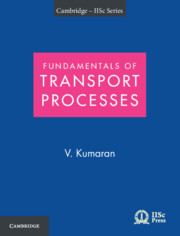Book contents
- Frontmatter
- Dedication
- Contents
- Preface
- 1 Introduction and Dimensional Analysis
- 2 Dimensionless Groups and Correlations
- 3 Diffusion and Dispersion
- 4 Unidirectional Transport: Cartesian Co-ordinates
- 5 Unidirectional Transport: Curvilinear Co-ordinates
- 6 Pressure-driven Flow
- 7 Conservation Equations
- 8 Diffusion Equation
- 9 Forced Convection
- 10 Natural Convection
- Bibliography
- Index
2 - Dimensionless Groups and Correlations
Published online by Cambridge University Press: 28 February 2025
- Frontmatter
- Dedication
- Contents
- Preface
- 1 Introduction and Dimensional Analysis
- 2 Dimensionless Groups and Correlations
- 3 Diffusion and Dispersion
- 4 Unidirectional Transport: Cartesian Co-ordinates
- 5 Unidirectional Transport: Curvilinear Co-ordinates
- 6 Pressure-driven Flow
- 7 Conservation Equations
- 8 Diffusion Equation
- 9 Forced Convection
- 10 Natural Convection
- Bibliography
- Index
Summary
The number of independent parameters in a problem is reduced when the dependent and independent parameters are expressed in dimensionless form. In the problem of the settling sphere in Section 1.6.1 and the flow through a pipe in Section 1.6.3, the original problem contained one dependent and four independent dimensional quantities. Using dimensional analysis, this was reduced to one independent and one dependent dimensionless groups. The mass transfer problem in Section 1.6.2 contained one dependent and six independent quantities. The problem was reduced to a relationship between one dependent and two independent dimensionless groups, using dimensional analysis and the assumption that the solute mass and total mass can be considered as different dimensions. In the heat transfer problem in Section 1.6.3, there were one dependent and eight independent dimensional quantities. This was reduced to a relationship between one dependent and three independent dimensionless groups, using dimensional analysis and the assumption that the thermal and mechanical energy can be considered as different dimensions. Thus, dimensional analysis has significantly reduced the number of parameters in the problem.
It is not possible to further simplify the problem using dimensional analysis. In order to progress further, experiments can be carried out to obtain empirical correlations between the dimensionless groups. Another option, pursued in this text, is to do analytical calculations based on a mathematical description of transport processes. Before proceeding to develop the methodology for the analytical calculations, a physical interpretation of the different dimensionless groups is provided in this chapter.
In dimensional analysis, there is ambiguity in the selection of the dimensional parameters for forming the dimensionless groups. This ambiguity is reduced by a physical understanding of the dimensionless groups as the ratio of different types of forces. Here, a broad framework is established for understanding the different dimensionless groups and the relations between them. The forms of the correlations depend on several factors, such as the flow regime, flow patterns and the boundary conditions.
It is important to note that the correlations listed here are indicative, but not exhaustive. Some commonly used correlations are presented to obtain a physical understanding of the terms in the correlation, and to illustrate their application. More accurate correlations applicable in specific domains can be found in specialised handbooks/technical reports.
- Type
- Chapter
- Information
- Fundamentals of Transport Processes with Applications , pp. 45 - 104Publisher: Cambridge University PressPrint publication year: 2023

